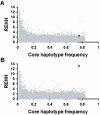Genetic signatures of strong recent positive selection at the lactase gene
- PMID: 15114531
- PMCID: PMC1182075
- DOI: 10.1086/421051
Genetic signatures of strong recent positive selection at the lactase gene
Abstract
In most human populations, the ability to digest lactose contained in milk usually disappears in childhood, but in European-derived populations, lactase activity frequently persists into adulthood (Scrimshaw and Murray 1988). It has been suggested (Cavalli-Sforza 1973; Hollox et al. 2001; Enattah et al. 2002; Poulter et al. 2003) that a selective advantage based on additional nutrition from dairy explains these genetically determined population differences (Simoons 1970; Kretchmer 1971; Scrimshaw and Murray 1988; Enattah et al. 2002), but formal population-genetics-based evidence of selection has not yet been provided. To assess the population-genetics evidence for selection, we typed 101 single-nucleotide polymorphisms covering 3.2 Mb around the lactase gene. In northern European-derived populations, two alleles that are tightly associated with lactase persistence (Enattah et al. 2002) uniquely mark a common (~77%) haplotype that extends largely undisrupted for >1 Mb. We provide two new lines of genetic evidence that this long, common haplotype arose rapidly due to recent selection: (1) by use of the traditional F(ST) measure and a novel test based on p(excess), we demonstrate large frequency differences among populations for the persistence-associated markers and for flanking markers throughout the haplotype, and (2) we show that the haplotype is unusually long, given its high frequency--a hallmark of recent selection. We estimate that strong selection occurred within the past 5,000-10,000 years, consistent with an advantage to lactase persistence in the setting of dairy farming; the signals of selection we observe are among the strongest yet seen for any gene in the genome.
Figures



References
Electronic-Database Information
-
- Coriell Institute for Medical Research, http://locus.umdnj.edu/ccr/
-
- dbSNP Home Page, http://www.ncbi.nlm.nih.gov/SNP/
-
- HapMap Project, http://www.hapmap.org
-
- Online Mendelian Inheritance in Man (OMIM), http://www.ncbi.nlm.nih.gov/Omim/ (for HBB, G6PD, FY, TNFSF5, CKR5, HFE, ADH1B, CFTR, and LCT)
References
-
- Altshuler D, Hirschhorn JN, Klannemark M, Lindgren CM, Vohl MC, Nemesh J, Lane CR, Schaffner SF, Bolk S, Brewer C, Tuomi T, Gaudet D, Hudson TJ, Daly M, Groop L, Lander ES (2000) The common PPARγ Pro12Ala polymorphism is associated with decreased risk of type 2 diabetes. Nat Genet 26:76–8010.1038/79216 - DOI - PubMed
-
- Bayless TM, Rosensweig NS (1966) A racial difference in incidence of lactase deficiency: a survey of milk intolerance and lactase deficiency in healthy adult males. JAMA 197:968–972 - PubMed
Publication types
MeSH terms
Substances
LinkOut - more resources
Full Text Sources
Other Literature Sources
Molecular Biology Databases
Research Materials
Miscellaneous

